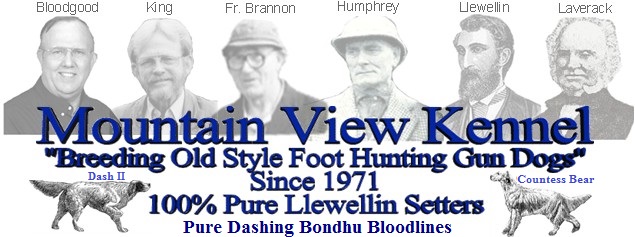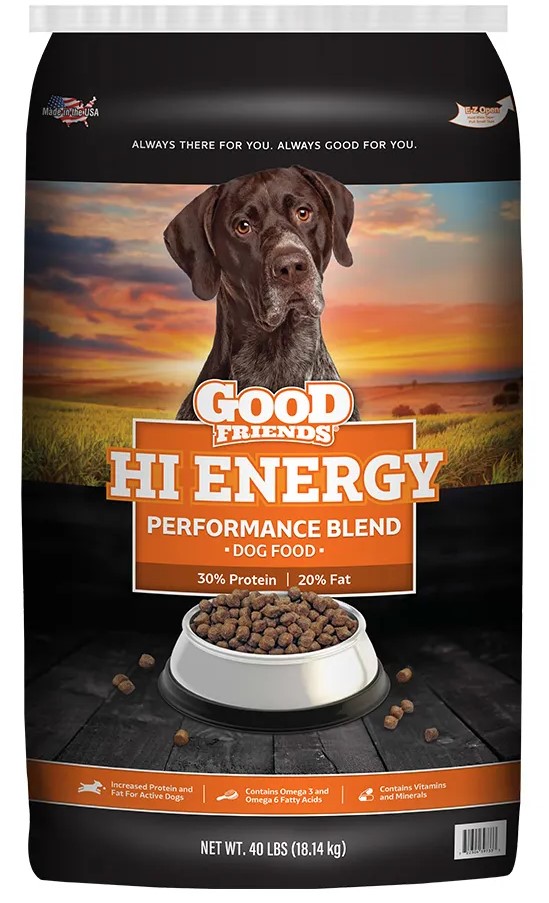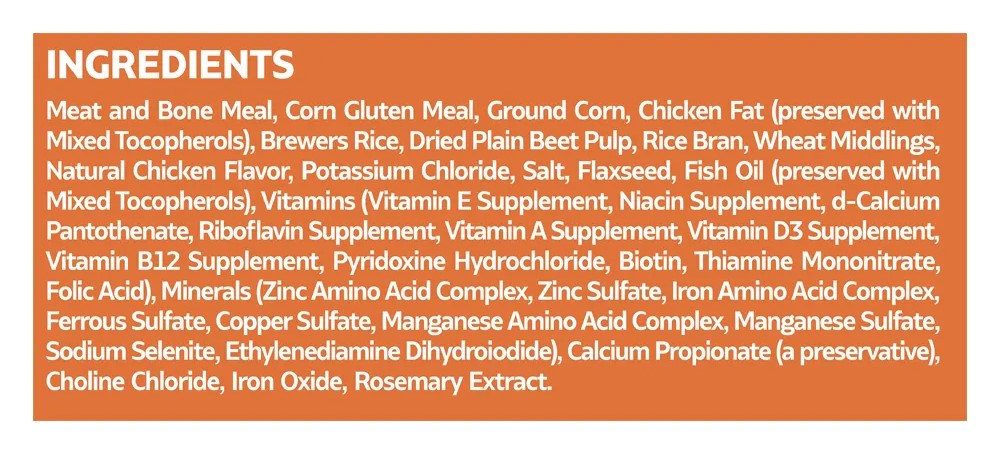How we raise our pups at
Mountain View Kennel, LLC.We have been breeding dogs for 52+ years now and have learned how to raise outstanding healthy pups, generation after generation. We have found that it's best to wean females from their pups around the day they become 5 weeks old and no later than 6 weeks old and then females are only nursed for 5 minutes for a day or two after if needed to dry them up properly.This practice does three things. #1. it keeps the females from being pulled down physically by their pups, resulting in less time for mothers to recover fully and be physically ready to hunt and or breed again. # 2. it keeps their teats small and at a near normal size, so they can continue to hunt without getting them scratched up and able to raise new born puppies in the future # 3. It helps socialize our pups to people early on, making them rely on us for their food and care, basically imprinting them and helping to remove any possible shyness.
Even after several litters our females have normal sized teats and appear to not even of had a litter or two. Females that are allowed to be pulled down by their pups are much more likely to have many health issues later on in life. Females with large teats will loose newborns in their future litters, because some of their teats are too large for the small pups making them poor for raising pups in the future if at all. Not to mention how they will get their teats torn up while hunting, and are more prone to having mastitis, tumors, or breast cancer. We have never had any of these problems in our dogs, so we must be doing something right.
The only females we have ever owned with elongated teats and have problems raising pups, are those that raised litters before we purchased them. We never breed females unless they are in perfect health and condition.
We also put a lot of emphasis on our females and their pups nutrition, by feeding very high quality dog foods and adding goat-lambs milk replacer to their diet for extra calcium, etc. and a good worming schedule starting at 2 weeks.
This not only assures us that the females don't get physically pulled down, but also builds a stronger physical body and hind quarters in their pups. This will add years of hunting enjoyment and quality of life when our pups become older. It has been our experience that the dogs we raise, hunt and live 3-4 years longer than those we have purchased from other kennels.
Our vaccine schedule starting at 4 weeks with the newest Parvo Vaccine on the market that will protect the pup from all known Parvo strains. Parvo, is the number one killer of young pups. We maintain a Parvo Free Kennel, but vaccine them at 5 weeks old and every 2-3 weeks so they are protected when they leave.
We also feed a high quality adult dog food between litters and exercise our dogs as much as possible and purposely hunt them when we can or at least exercise them vigorously up to two weeks before their whelping date.
This has always been our practice, but now has been scientifically proven that puppy's out of females that are vigorously hunted/exercised up till their last two weeks of pregnancy, are able to handle adrenaline and other stress related chemicals in their bloodstream and their pups are able to produce more of these chemicals in their bloodstream making them able to learn quicker, handled stress better, and became better more natural hunting dogs with less training. This was scientifically proven using the same parents in both studies, one being hunted/exercised up till 2 weeks before birth and another without any hunting or exercise. The differences were amazing in the pups from the same parents and clearly made those hunted and/or exercised much easier to train. Not to mention the muscle tone of the females making their birthing experience less problematic. Might be why in 52+ years of breeding dogs we have NEVER required one C-section or a loss of a mother or whole litter while having pups.
As you can see we have put a lot of thought and years of personal research, wisdom and tons of hard work into raising each and every pup. We have also put even more emphasis on our selective breeding part of our program and is why we can offer a 100% Life-Time Satisfaction Replacement Guarantee on every pup we place, but we will leave it to our customers and to our Lord to decide how we are doing.
Front Dew Claws

The reason front dew claws are removed from many bird dogs, is because in many breeds, their front dew claws have become poorly developed and have no function anymore. They just hang out dangling getting caught and torn on grasses, thorns, and brush, that can cause soreness' and even infection, losing valuable time in the field and causing the dog unnecessary pain. They are easily removed from most bird dog breeds with just a snip of a toe nail clipper at a few days old. We did this for many generations while breeding German Shorthair Pointers.
We attempted to clip off the front dew claws in our first two litters of pure Dashing Bondhu Llewellin Setters and all the pups had problems healing and required antibiotics. Many required more clipping to remove the extended bones and were left with large scars on them. This also upset their mothers and was a bad experience for all involved.
So we investigated further and realized that unlike many other breeds today, the pure Dashing Bondhu Llewellin Setters front dew claws are VERY highly developed with very strong muscles, ligaments, and bones forming an intricate working thumb. We have found that they should not be removed by simply clipping them off. Removing them is like removing a functioning thumb from a person and to do so properly, would require surgery to remove the whole structure, not just the front dew claw.
Their front dew claw structure actually continues up along the side and inside of their front legs and does not dangle freely, like in other bird dog breeds. Because it is so developed, removing it may be like removing a big toe and may interfere with their balance. In fact it has now been proven that dogs do use them when turning sharply, pulling them after braking through the ice, climbing over logs, etc. and dogs without them are much more likely to have lower leg injuries.
As puppies their front dew claw may look a little large, loose, and dangly, but as they continue to develop, they will become leaner, stronger and they will hold it tightly up against their front foot out of the way of trouble. They will even use it to climb over things, like over fallen trees, rock walls, and rough terrain while hunting and will even pull them out after falling through the ice. So unlike other bird dog breeds, these actually have a function and are an asset to them in the field and woods and may even save their life.
All the Dashing Bondhu Setters we purchased had them and but for those first two litters of pups, all of our Setters and pups have them and we have never had a single problem or heard of a single problem from all our customers. It's very interesting to think that they may be the last breed or line of dogs who still have functioning front dew claws, or should I say thumbs. I think that it is amazing that Llewellin and Humphrey must have bred these dogs down to the development of their front dew claws being better developed. We have not had any Llewellin Setter pups born with rare dew claws on their hind feet.
BTW, All our Setters have front dew claws and we hunt all our Setters and have never had any problems with their dew claws hunted under the worst grasses and cover conditions.
The Functionality of Canine Dew Claws
The Function of Dewclaws 101Front dewclaws are typically removed by some at 3-5 days of age, because they are believed to be a non-functional digit that poses an unnecessary risk for being injured.
In standing, the front dewclaw may not appear to be functional because it doesn't come in contact with the ground. However, observing the dewclaw when the dog is in motion tells a different story.
Five tendons attach to the dewclaw and play an important role when the dog is in motion. For example:
- When a dog’s lead leg is on the ground during the gallop or canter, the dewclaw is on the ground to stabilize the carpus
- When a dog turns, the dewclaw digs into the ground to support the structures of the limb and prevent torque
If a dog does not have dewclaws, there is a higher potential for the carpal ligaments to stretch and tear which could result in laxity and arthritis over time (OUCH!). This can then result in more stress being generated through the dog's carpus, elbow, shoulder, and spine as it tries to compensate for the lack of digit.
On the other hand, the rear dewclaws do not have associated tendons and are considered non-functional (though they may be required for some breed standards to be present).
In speaking with many vets, you would be surprised at how few dewclaw injuries they see.
So- given the front dewclaws' functional use, why are we so quick to remove them?
In dogs, the most common injuries seen by many rehab providers and vets occur in the shoulder complex, yet we don’t see shoulders being removed. Food for thought!
Here are some cool videos proving the functionality of dewclaws in dogs:
https://www.youtube.com/watch?v=yp2xHj_NJn4
Delayed ClosuresUnfortunately, with raising fat rollie pollie puppies, we increase the number of "Delayed closures" and they are just that. The fatter the pup the increase number we get. We hardly ever got them until after feeding high quality puppy foods. The choice we have is to raise slender pups, or to educate our customers. Since we want to make sure our pups are getting the best start possible to live a long healthy life, we are going with the latter.
There is an area in the abdominal wall where the great vessels of the umbilical cord exit the body of the fetus to derive nutrition and oxygen from the placenta. After birth, these vessels close and shrink up. There is left behind a small area in the mid line where the vessels formerly escaped the body. The nature of this structure is a linear slit in the middling, lined with normal connective tissue. There are other structures on the 'middling' that undergo similar development after birth. In the heart, there is a hole between the upper chambers that allows the fetus to bypass the lungs, which, of course, cannot contribute any oxygen to the blood before birth. Oxygen is obtained through the umbilical cord from the placenta, where the mother's blood stream exchanges oxygen and carbon dioxide with the baby's circulation. When there are delayed closures in the heart, it may be possible to hear a murmur at 4 or 5 weeks that is no longer audible by 6 or 8 weeks. This is normal development. These holes, like the umbilicus, must be present in the fetus and close over a period of time after birth.
Omentum is a kind of slippery thin sheet of tissue which is present in the abdomen. It provides several services to the abdominal organs. It has blood vessels traveling through it to the intestine. Its surfaces produce serious fluid which lubricates the abdominal organs and makes it possible for them to slide against each other without rubbing. It carries lymph nodes for the abdomen, and is a major depot for fat storage. It partially contains the abdominal organs - especially the small intestine - and supports them in a kind of "plastic bag". As the puppy puts on weight, it is possible for a bit of this thin slippery tissue to protrude through the umbilical slit. As the normal process of closing of the umbilicus proceeds, it is possible for this bit of tissue/fat to be entrapped. The danger here is whether it is solely Omentum that is escaping, or if the defect is large enough for a loop of small intestine to escape the abdomen as well.
It helps to "reduce" the tissue escaping once daily. Turn the puppy on its back and gently massage the protrusion and slide the contents back up into the abdomen. This lowers the risk of a loop of intestine becoming strangulated in the protruding tissue.
If the 'hernia' is a closure defect, the normal process of closing will continue, and at some point a small amount of momentum may be entrapped in a bubble outside the essentially closed body wall. This is viewed by most people as a hernia, and a serious problem, but if the dog has a small bubble, or 'outsy belly button', and it cannot be reduced, has been there since it was a baby, and the dog is healthy and well, it is pretty obvious that the bubble does not contain any intestine. While the puppy is younger, it may not be clear. The very tiny holes the size of a pinkie tip with a small bubble do not require surgery. Only larger holes should be closed to be sure that no intestine becomes strangulated in the process of closure.
NOTE: no delayed closure can ever close completely simply because there is something sticking through it. If there were no momentum sliding out, they would continue to close normally. What they do, is they close tightly around the momentum, trapping it outside in an absolutely firm unchanging bubble and is perfectly all right and should not effect the selection process for breeding.
"True" umbilical hernias can make no progress in closing, ever and will grow bigger as the pup grows bigger. They are usually large and must always be surgically repaired when the pup is at least 4 months old. These can be quite serious, but easy to recognize at an older age. Unless an emergency, pups should not be operated on until 4 months or older anyway.
Fortunately, they are VERY rare and not at all likely in a pure Dashing Bondhu Llewellin Setters, but with all things, anything can be possible as a birth defect (non inherited). These are easily spotted and if a pup of ours would have a "true hernia", it will be included in their description we send or post and price reduced for their future surgery. To this day none have happened, but have had two customers and their Vets who choose to fix them right away surgically.
I have never seen a female with a delayed closure or with a trapped momentum bubble show any sign of problem in carrying a litter or whelping, even a very large litter. I have never seen one of these females produce puppies with hernias.
The catch is, you must know which you have. Most veterinarians don't draw these kinds of conclusions or try to differentiate the two different conditions and some will automatically recommend unnecessary surgery. Breeders with years of experience know the difference intuitively. Indeed, since "true" hernias are relatively rare, most have never seen one, unless they bred a line that produced them in the past. In any case, the breeder knows better if the line they are breeding will produce "true" hernias and should know best how to differentiate between the two.
So if your pup turns out to have a small pinkie tip size hole, just follow the recommended procedure above and it should not become any bigger and as the pup grows it will become inconsequential.
In the unlikely event that one would continue to grow larger and not completely close and require fixing later on, it can easily be fixed when they are spayed or neutered for a little extra. Of course we do stand behind every pup we sell and will refund the buyer $100 the cost of what our vet charges for fixing one if it is required to fix it without a spay and only $25. more if done during a spay. Please, do not let a vet operate on a small puppy, just follow the daily recommendations above and wait until at least 6 months old to reevaluate them, over 99% will be almost closed if not completely close by then.
Reference: http://www.showdogsupersite.com/kenlclub/breedvet/umbilical.html




